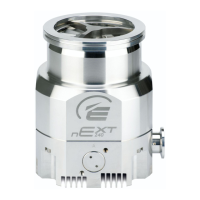© Edwards Limited 2013. All rights reserved. Page 3
Edwards and the Edwards logo are trademarks of Edwards Limited.
Introduction
B800-00-880 Issue D
1.3 Pump controller
The pump controller contains the drive electronics that control the pump operation and the TAV vent valve. There
is a connector socket on the side of the controller where the TAV vent valve can be plugged in. (Refer to Section 2.9)
The controller has three indicator LED’s that signal the general status, operation and service status of the pump.The
LEDs can be used for fault finding if a problem should occur. (Refer to Section 2.10)
The drive electronics system has a number of built-in safety features to protect the nEXT pumps from damage in the
event of sustained high pressure or temperature.
The electronics constantly monitors the temperature inside the controller and the temperature of the motor
within the pump. If either part becomes too hot, the controller reduces the power supplied to the pump
motor and the pump speed will drop. If the pump rotational speed falls below 50% of full speed, the
electronics may trip into a Fail condition, depending on the system configuration. (Refer to Section 1.4.3).
If the pump inlet pressure increases, the power supplied to the pump motor increases to counteract the gas
frictional load. However, when the built-in maximum power limit is reached, the speed of the pump will start
to drop. If the pump rotational speed falls below 50%% full speed, the electronics may trip into Fail
condition, depending on how the system has been configured. (Refer to Section 1.4.3).
In the event of an electrical supply failure, the controller uses the motor within the pump as a generator.
This means the nEXT pumps have their own regenerative supply and do not require a separate battery for
emergency power backup. The regenerated energy is used to maintain the electrical supply to the controller
and any vent valve or fan attached to the controller connector until the pump speed falls to below 50% of full
rotational speed: this will ensure that the vent valve remains shut until below 50% of full rotational speed
and will prevent the pump from venting at full speed. It also ensures that the serial link and signals on the
parallel interface remain active until the pump speed falls below 50%.
1.4 Operational features
In addition to the basic start and stop commands, the nEXT pumps have several other features that allow pump
operation to be tailored to a particular application. Refer to Table 10 for factory default settings of the parameters
discussed in the following sections.
OEM supplied pumps may have drive parameters and default user-selectable settings which differ from those stated
in this instruction manual in order to suit certain process requirements. Please contact the OEM in the first instance
for further information and advice.
1.4.1 Power limit setting
Select the maximum power that will be drawn by the pump (refer to Section 4.1.1). The more power supplied, the
quicker the pump will accelerate to reach full speed. If the application requires fast cycling, set the power limit to
the maximum value. If ramp time is not important in the application, use a lower power limit, down to a minimum
value (refer to Table 1).
Ensure that the power supply is capable of delivering sufficient power to the nEXT pump. By choosing a lower power
limit setting, a smaller power supply may be used. For more information, refer to Section 2.7.
Table 1 - Power limits
Pump Standard default setting
Maximum value
setting
Minimum value setting
nEXT240, nEXT300 and nEXT400 160 W 200 W 50 W

